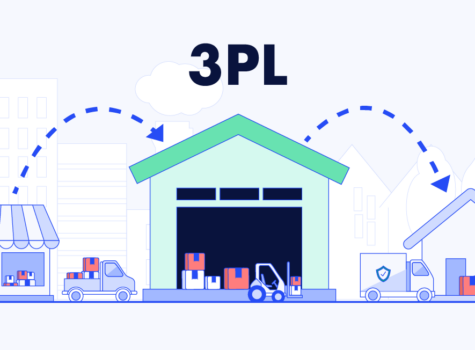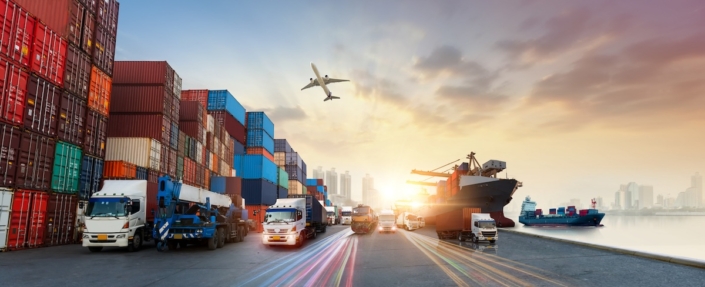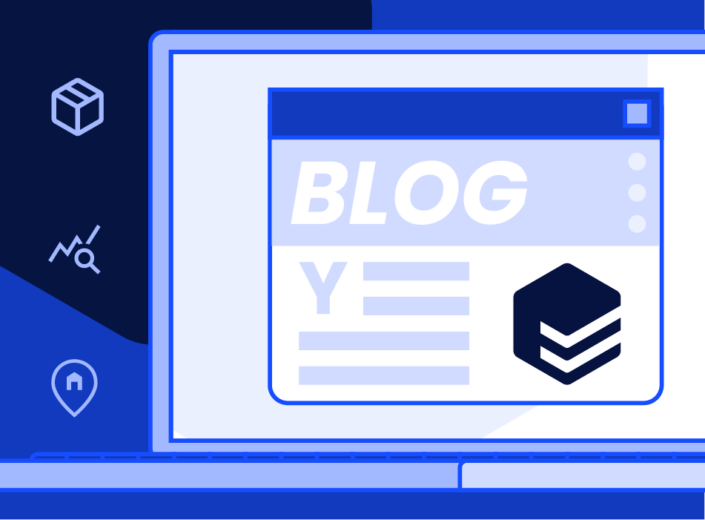Running an ecommerce business can feel like you’re spinning glass plates on sticks: product design, marketing, sales, customer service, and the ever-wobbly plate of order fulfillment. But what if you could trust someone else to keep that last plate from crashing down?
When you partner with a third-party logistics provider, or 3PL, they handle the order fulfillment process from start to finish, giving you more time to focus on revenue-generating activities.
What is a third-party logistics provider (3PL)?
A 3PL is an external partner that handles order fulfillment services such as inventory management, warehousing, transportation, distribution, and returns. They do what Inbound Logistics calls “the bread-and-butter work”: receive, pick, pack, and ship orders. Third-party logistics providers can also perform more specialized services, such as customization or customer service. Businesses outsource their fulfillment to 3PLs so they have more time to focus on their core competencies.
When businesses grow, the complexities of managing logistics in-house grow as well. As you scale, your systems and processes have to evolve. Of course, you can manage the order fulfillment process yourself—but is it worth the time and energy?
Third-party logistics frees your business from the complexities of in-house order fulfillment. Because 3PLs are industry experts, they’re equipped with the knowledge, technology, and networks to manage the fulfillment process efficiently. In the long run, you’ll save time, spend less, and maintain high levels of customer satisfaction. Let’s take a closer look at how 3PLs make this possible.
How 3PLs work
When you work with third-party logistics services, your business continues the work of developing products, setting up an ecommerce store, and attracting customers. But once a customer places an order, the 3PL takes over to facilitate the seamless movement of goods from their distribution centers to your customers.
So how do 3PLs work? We’ll break it down into six key stages, beginning with receiving.
Receiving
First things first: you need to send your inventory to the 3PL so they can start fulfilling orders.
Each 3PL has its own process for receiving inventory, and they can often customize to meet your needs. You’ll probably have to fill out a form beforehand detailing what you’re sending, including the tracking information and estimated arrival time. Some 3PLs might require you to make a delivery appointment to ensure a smoother process.
After coordinating the delivery details, you can ship inventory directly from your manufacturer to the 3PL distribution centers. Once the delivery arrives, workers check that the goods match the accompanying documentation, preventing errors or discrepancies down the line.
Inventory/warehouse storing
Once your products arrive at the 3PL warehouse, they find their temporary home in bins or on shelves. Each product is labeled with an SKU (stock-keeping unit), which is a scannable code that lets the 3PL easily track the movement of inventory. 3PL warehouses are carefully designed to maximize space and optimize inventory management, and most use inventory tracking systems that provide real-time visibility into stock levels.
It’s important to choose a 3PL with enough warehouse space to store all your inventory, both now and in the future. Similarly, you’ll want to make sure they have fulfillment centers in the right locations to ship to your customers. For example, if you mostly ship to the Eastern US, you’ll need a 3PL with a presence in that region. Choosing a third-party logistics provider that scales with your company will make things easier as your business grows.
Picking
After the 3PL has received and stored your inventory, it remains in the warehouse until a customer places an order online. At this point, the order information travels to the 3PL in one of two ways:
- If your 3PL has technology that integrates with your order management system (OMS), their system will automatically pull in new orders.
- If not, you’ll need to upload orders manually.
Then it’s time to pick! The 3PL’s team of pickers gets a list of SKUs, quantities, and locations in the warehouse. Many 3PLs use sophisticated technology that determines the most efficient path to products, minimizing the time and effort it takes to gather them. The pickers follow these efficient routes, take the required stock out of storage, and prepare it to be packed.
Packing
After items are picked, they move to the packing stage. Workers start by choosing the best packaging materials to make sure that nothing gets damaged during transportation. They also optimize for cost, making sure packages aren’t too big or too small. With this attention to detail, 3PLs maximize the chances of goods arriving in pristine condition.
While some 3PLs charge separately for packing materials, others include it in the total cost. Some even allow for custom packaging for brands who want to send specially-designed packages to their customers.
Shipping
Once orders are picked and packed, it’s time to ship them to customers. Third-party logistics providers leverage their vast network of carriers to choose the most suitable and cost-effective shipping methods. They take advantage of partnerships for lower rates or use a shipping API to easily find the best deals.
After the 3PL prints shipping labels and attaches them to packages, carriers pick up orders from warehouses and deliver them to the customer. With the right technology integrations, they can send tracking information directly to your online store so buyers can track their packages.
Returns
Though returns are more common in some industries than others, there’s always a chance that a customer will want a replacement or refund. When they send something back, the 3PL manages the reverse logistics process. They inspect returned products and reintegrate them into inventory if they’re in good enough condition to resell. If you want, they can even provide return shipping labels to customers to make the returns process as smooth as possible.
Three-quarters of consumer-focused shippers believe that the returns process is very important to consumer loyalty, and 65% report that customers’ expectations for returns are growing. For such an important element of the customer experience, it’s worth letting the logistics experts take charge.
The difference between 3PLs and 4PLs
3PLs and 4PLs both play important roles in supply chain management, but they take different approaches. 3PLs are outsourced extensions of a business’s logistics operations, offering expertise and resources to optimize the order fulfillment process. They focus on specific functions like transportation, warehousing, and preparing orders to ship.
On the other hand, 4PLs (fourth-party logistics providers) take on a more comprehensive role. Simply put, they oversee and integrate the entire supply chain. This includes coordinating multiple 3PLs and other service providers, aligning strategies, and providing end-to-end visibility into the supply chain ecosystem.
4PLs act as an extra layer between you and a 3PL. When you hire a 4PL, they take the lead in researching 3PLs, choosing the best one(s) for your business, and managing the relationship with them.
Services to look for in a 3PL
When researching potential 3PL partners, learn how they handle each of the following services.
Distributed inventory
3PLs strategically distribute inventory across multiple locations to improve shipping efficiency. By locating products close to customers and using technology to route orders to the right fulfillment center, 3PLs make sure that every order arrives as quickly as possible.
2-day shipping
Customers have come to expect 2-day shipping. By placing inventory close to customer locations, 3PLs can offer quick, affordable ground shipping. When evaluating 3PLs, make sure they can offer 2-day shipping to the regions you serve.
Customization
Often, personal touches resonate most with customers. While not every 3PL provides customization services, many of them do. These 3PLs help you deliver an outstanding unboxing experience by using branded packaging, personalized notes, and custom sender labels. Similarly, some 3PLs offer kitting services, where they group separate items together to create a more comprehensive product offering.
Returns management
Hassle-free returns management boosts customer satisfaction, whereas a cumbersome process can lead to frustration. A 3PL with a streamlined returns process handles returned items efficiently, providing a seamless experience for you and your customers.
Inventory management
Inventory management gives you full visibility into stock levels, reducing the risk of stockouts or overstocking. It’s the most common service offered by 3PLs. The best inventory management systems let you seamlessly sync inventory levels with your online store, view inventory in real time, and decide when it’s time to re-order products.
B2B and DTC fulfillment
To effectively manage both B2B (business-to-business) and DTC (direct-to-consumer) fulfillment, 3PLs must have a versatile infrastructure and operational capabilities.
Integration with your tech stack
Make sure the 3PL you work with can integrate with your existing tools and systems. This will streamline onboarding and help you preserve your existing supply chain processes.
While these services are important, it’s also helpful to understand broader trends. So what are brands looking for in a 3PL in 2023? One of the biggest attractions is technology, which three-quarters of shippers report plays a major role as they evaluate and select 3PL partnerships. Another big thing to look out for is customer service. Increasingly, companies prioritize customer service (81% say it’s a top factor in the decision-making process) over cost (just 19% name it as a top factor).
Top 3 third-party logistics providers
A simple Google search will show you countless third-party logistics providers. While it’s always great to have options, the sheer number of 3PLs out there can feel overwhelming. Here are a few that we recommend.
ShipBob
A global fulfillment solution with fulfillment centers in the US, UK, EU, Canada, and Australia, ShipBob is the trusted choice for over 7,000 DTC brands. Their powerful software drives better omnichannel experiences for customers, allowing you to offer custom unboxing experiences. ShipBob also makes it simple to manage orders, track inventory levels in real time, and decide when it’s time to reorder stock.
ShipMonk
ShipMonk has strategically located warehouses across the US, UK, Czech Republic, Mexico, and Canada. With a focus on helping ecommerce businesses grow, they provide a comprehensive order, inventory, and warehouse management solution. Because ShipMonk doesn’t have a monthly minimum for orders, they’re a great choice for smaller ecommerce businesses.
Whiplash
Whiplash’s facilities stretch across the US and UK. Their integration process is simple, and they have expertise in key retail sectors that can help businesses scale efficiently. Whiplash also has an API that lets you create customized apps that work seamlessly with your system.
When to start using a 3PL
Now you know how 3PLs work—but how do you know when to start using a 3PL? Simply put, it’s time to use a 3PL when you can’t keep up with orders on your own, you’re running low on inventory storage, or you need a more sophisticated order fulfillment system.
As your operations expand and evolve, it becomes more and more difficult to keep up with order fulfillment. Eventually, you’ll find yourself spending hours a day packing boxes and dropping them off with carriers. Supply chain disruptions caused by the Covid-19 pandemic and the Russia-Ukraine conflict make things even more difficult. Sixty-eight percent of businesses report that supply chain issues are negatively impacting their ability to fulfill customer demand.
Whether you’re scaling fast or struggling to stay afloat in tough economic times, a 3PL can help. Let’s explore a few indicators that partnering with a 3PL will lead to significant operational benefits.
You’re shipping 100+ orders each month
While there isn’t a set number of orders per month that signals you should get started with a 3PL, 100 is a good benchmark. If you receive over 100 orders a month, you probably spend a significant amount of time managing inventory, packing boxes, and shipping orders.
3PLs have the resources and infrastructure to efficiently handle high order volumes, making sure deliveries are timely and accurate. When you outsource to experts, you gain back time to focus on core business activities like marketing, customer acquisition, and product development—all the things you’re really good at. In short, you trade out time-consuming activities that don’t generate revenue for value-adding activities that fuel growth.
You’re running low on inventory storage
Is inventory slowly filling up your spare garage, office, or living room? Even worse, are your warehouse costs rising? Running out of storage space for inventory is a sign that it’s time to consider a third-party logistics solution. Third-party logistics services give you access to strategically placed warehouses across the country (and sometimes internationally). They also use advanced inventory management technology to track stock levels.
Moving to a 3PL expands your inventory storage space, saves time and effort, and—most importantly—makes it easier to scale your business. If you’re already renting warehouse space, combining storage and fulfillment costs just makes sense.
You have complex shipping requirements
Many factors can make shipping requirements more intricate: multiple shipping destinations, various package sizes, international shipping, and so on. Additionally, many industries ship products with special requirements. These could include:
- Temperature-sensitive products like perishable foods or pharmaceuticals
- Chemicals and hazardous materials
- Fragile products like glassware or artwork
- Oversized items such as farm equipment
- High-value goods, including electronics and jewelry
If you don’t feel up to handling these complexities, you can put them in the hands of a 3PL. With their wealth of experience navigating the world of shipping, 3PLs are well-prepared to optimize routes, manage customs regulations, and find the most cost-effective solutions.
You want to offer free 2-day shipping
In the era of fast-paced ecommerce, offering fast, free shipping gives your business a competitive edge. Over 90% of online shoppers in the US expect free 2- to 3-day shipping, and 60% of global consumers expect same-, next-, or 2-day delivery. And free shipping doesn’t just attract customers—it also encourages them to spend more.
It’s clear that offering free 2-day shipping is the right strategy. However, achieving this level of service requires efficient logistics and strategically located distribution centers. That’s where 3PLs come in. By placing inventory near major population centers, 3PLs enable faster shipping times, elevating customer satisfaction and encouraging repeat business.
Advantages of 3PLs
Working with third-party logistics (3PL) providers can bring a host of benefits to your business, including cost savings, expanded reach, and faster order fulfillment.
Saves time, money, and space
Storing inventory at home quickly becomes unsustainable. When it’s time to upgrade to a warehouse, the costs may take you by surprise. When you operate your own warehouse, you pay for the space, equipment, warehouse management system (WMS), labor, workers’ comp, liability insurance—and the list goes on. In addition to the money you spend on these things, you also spend time managing the warehouse to make sure nothing goes wrong.
Outsourcing logistics functions to a 3PL reduces the need for investments in warehousing and personnel, letting you focus on core business activities.
Helps expand your reach
3PLs have established networks and distribution centers, which allow you to tap into regions that might have been logistically challenging otherwise. This efficient scaling helps you reach new markets more quickly.
Faster order fulfillment
Knowing the importance of fast, accurate shipping, every business does its best to send out orders on time. But when order volume begins to increase, it gets harder to keep the fulfillment system running smoothly. Thankfully, 3PLs specialize in efficient order fulfillment. They streamline processes and leverage technology to shorten delivery times, enhancing customer satisfaction and loyalty.
Disadvantages of 3PLs
While 3PLs offer many benefits, it’s also important to consider potential drawbacks.
Requires an upfront investment
While investing in a 3PL partnership leads to long-term savings, it often involves an upfront cost. This can pose a financial challenge that acts as a barrier for businesses. Here’s what you pay for when you outsource fulfillment to a 3PL.
Initial costs:
- Onboarding
- Technology integration
- Setting up processes
Ongoing costs:
- Inventory receiving and storage
- Order picking and packing
- Packaging
- Kitting
- Shipping
While some 3PLs bundle these costs, others charge separate fees for different services. This can make it difficult to get an accurate idea of how much you’ll be spending.
Different working hours and processes
3PLs have their own schedules and processes, which can lead to communication gaps or delays, especially when quick decisions are required. It can take extra effort from both parties to align working hours and strategies.
FAQs about 3PLs
Why are third-party logistics important?
Third-party logistics (3PL) are important because they help businesses streamline their operations, cut costs, and boost efficiency in the supply chain. Partnering with a 3PL allows you to devote more time to your core competencies, ultimately boosting revenue.
Do 3PLs take away my control?
Some people worry that by having a 3PL handle their shipping and logistics, they’re losing control of the process. In fact, the opposite is true! 3PLs actually give you back control by saving time and money. They offer expertise, technology, and streamlined processes that allow you to focus more on what your business does best.
Are 3PLs only for enterprise-sized companies?
You might be thinking, “My business just isn’t big enough for a 3PL yet.” And you might be right (see the section above titled “When to start using a 3PL”). But 3PLs are not just for large companies. They make it easier for businesses of any size to grow. If you have a small or medium-sized business, you can find a 3PL that tailors solutions to your needs and budget.
How do you measure the performance of a 3PL?
You can measure a 3PL’s performance by tracking a variety of metrics, including:
- On time and in full (OTIF): the percentage of shipments that are delivered on or before the agreed-upon delivery date and include all the items the customer ordered. OTIF shouldn’t drop below 90%, but the higher it is, the better.
- Inventory accuracy: the accuracy of inventory records. This metric should be as close to 100% as possible (learn how to calculate it here).
- Lead time: the time it takes to process and fulfill an order from the time it’s received. One week is considered a long lead time, and many consumers expect a lead time of around two days.
- Cost per unit (CPU): the total cost of outsourcing to the 3PL divided by the number of units shipped. CPU is different for every business, but it should stay fairly consistent. If your CPU spikes, take a closer look at the charges to see what’s going on.
- Returns processing efficiency: the time it takes to process returns and restock inventory. At least 95% of returns should be processed within the agreed-upon time period (generally 48 to 72 hours).
What industries use 3PLs the most often?
While 3PLs can be valuable for any industry, industries such as ecommerce, retail, automotive, and pharmaceuticals often rely heavily on 3PL services.
Do 3PLs have hidden fees?
Reputable 3PLs are open about their pricing structures. If you ask the right questions upfront, and carefully review their terms, you will know what fees and requirements there are when partnering with them. Clearly communicating will help you avoid unpleasant surprises and build a mutually beneficial relationship.
How should you manage a 3PL?
The best way to manage a 3PL is to set clear expectations at the start of your partnership, then maintain regular communication. If you already have open communication channels, it’s much easier to find solutions when issues arise. Additionally, you should consistently monitor the 3PL’s performance using the metrics above.
What’s the difference between a 3PL and a freight forwarder?
Freight forwarders and 3PLs both offer outsourced logistics services, but they focus on different things. Freight forwarders arrange transportation and associated documentation, acting as an intermediary between shippers and carriers. 3PLs offer a more comprehensive collection of services including transportation, warehousing, inventory management, and distribution.
Want to keep fulfillment in-house?
While 3PLs are valuable resources, some businesses prefer to maintain full control over the order fulfillment process. If you prefer to keep fulfillment in-house, you’ll need the right shipping technology to cost-effectively choose shipping carriers, generate labels, track packages, and more.
EasyPost’s suite of shipping APIs is the perfect solution for businesses of all sizes. With near-perfect uptime, a wide range of tools, and access to over 100 carriers, EasyPost can help your organization streamline fulfillment without breaking the bank.




